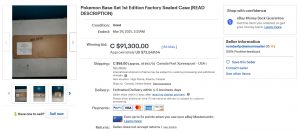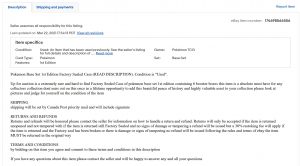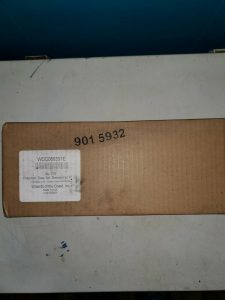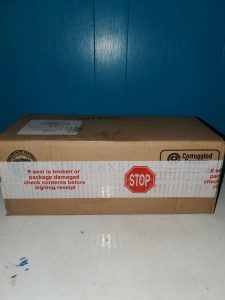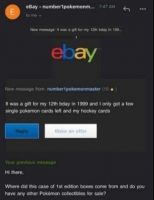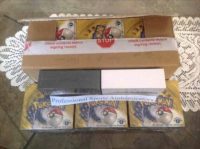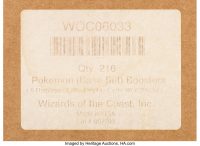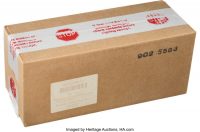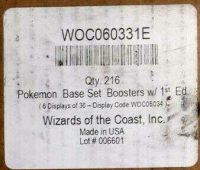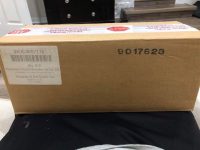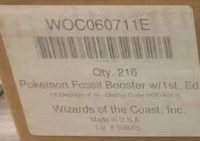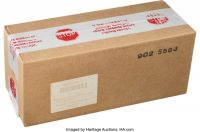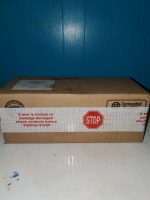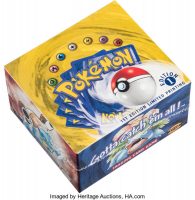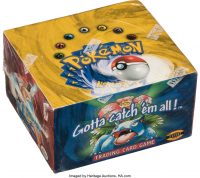Logan Paul’s $3.5 Million ‘Base Set’ Case May Be Fake: Pokemon Community Uncovers Significant Evidence
Earlier this month YouTuber Logan Paul announced he purchased a case of 1st edition Base Set booster boxes for $3.5 million. The news spread across gaming outlets and social media like wildfire and was touted as the most expensive purchase in the history of the Pokemon TCG. After all, it’s incredibly rare for someone to uncover six booster boxes of the original Pokemon set.
just dropped $3,500,000 on this sealed & authenticated box of 1st Edition Pokémon cards ? pic.twitter.com/rMY2bVnKV2
— Logan Paul (@LoganPaul) December 20, 2021
However, I did not report the announcement on PokeBeach because we had doubts about the product’s legitimacy. Now investigations by members of the Pokemon community have uncovered significant evidence that may show the product isn’t authentic.
YouTuber Rattle was the first to compile most of this evidence, some of which was known eight months before Logan Paul made his purchase. Rattle also kindly helped me with this news story!
Purchase History
The Base Set case first appeared on Canada’s eBay site on March 29th, 2021. Fans could place their bids for 10 days. The seller “number1pokemonmaster“ had almost no feedback and their listing was riddled with significant grammar errors. The seller also changed their username right before the auction went live, as if to hide their history.
Many collectors in our community immediately assumed the auction was a scam. The seller advertised the box as a “once in a lifetime opportunity” so clearly understood its value. Yet someone who understands the value of this item wouldn’t also sell it on eBay and ship it to the winner for $30 via Canada Post. They’ll usually contact an auction house or respected seller (or be advised to do so). Short of that, they’ll allow a buyer to fly out and inspect the item before flying it home.
The history or “story” of expensive items is also essential for their sale. Buyers need to know how items changed hands in order to verify their authenticity and origins. But the seller told three different origin stories (“you wanna know how I got these scars?”). He originally stated he bought it in Canada from an old woman during an estate sale. Then over DM, he told a potential buyer it was a gift for his 12th birthday. A third story later emerged, but we’ll get to that in a bit.
The auction ended on April 9th with 86 bids — the highest bid was only $72,500. This indicated Pokemon’s most serious collectors weren’t interested in the item. If they thought it was real, they would have bid above and beyond that amount. After all, individual boxes of 1st edition Base Set have been going for over $430,000 each. A sealed case has six of them, presumably in near-perfect condition, so the case would be worth a minimum of $2.6 million. The lukewarm response is enough to tell you people thought something was amiss.
The seller accepted the highest bid, which was made by @psapikachu for $72,500. Both he and the seller agreed to cancel the eBay auction and continue their deal off eBay for more than the winning bid. However, @psapikachu bailed when the seller wouldn’t let him fly over to inspect the box. Hiding the box from inspection was yet another red flag.
The seller next offered the box to @cardkahuna, who purchased it for an undisclosed price. The box was shipped to him in the United States… without insurance…
@cardkahuna then made a video showing he and his friends receiving the box. According to them an authentication company named Baseball Card Exchange was present to authenticate the box. While their company has significant presence and experience in the world of sports collectibles, their reputation is non-existent in the Pokemon community when it comes to authenticating anything other than individual booster packs. Nevertheless, they stated the box was real and then wrapped it in their company’s shrink wrap.
But the company did not publicly show their authentication process. When a hot ticket item has this much controversy, companies usually go into detail about their process by displaying their evidence (for example, CGC posts all sorts of forensic analysis for controversial items, like the prototype Base Set Blastoise card). Before the box ever reached this stage, some collectors predicted it would be authenticated by a relatively inexperienced company to give it legitimacy.
During the video a third origin story was revealed. The seller conveyed to the buyer that he bought a house in Canada and found the box in the attic. It’s a running joke in collecting circles that there’s always some kind of scam going on if a valuable item is found in a storage locker, abandoned warehouse, or through an ex-Wizard of the Coast employee. It’s the TCG’s version of “my uncle works at Nintendo.” Regardless, this was now the seller’s third conflicting story.
From here @cardkahuna sold the box for $2.7 million to sports card enthusiast @shyne150. Then he sold it to Logan Paul for $3.5 million, as you can see in Paul’s announcement video. Each time the box was flipped for a higher price.
the only known one in the world pic.twitter.com/UZEAavgD8e
— Logan Paul (@LoganPaul) December 20, 2021
Note that in the video they mention this is the only Base Set case to exist. This isn’t true, Gary Haase (King Pokemon) owns one. Some have also gone up for auction over the years. It doesn’t seem like the sports collectors in the video knew what they were talking about.
I should note that some of this “timeline” was compiled from different sources and may be missing information or insight. As usual, I will make updates to this post if necessary.
Red Flags on the Box Itself
Wizards of the Coast printed Pokemon products with a label listing the product code and a corresponding barcode. All known cases of Base Set that have sold over the years have been seen with the product code “WOC06033,” whether they were 1st edition or not.
Paul’s case has a label with the code “WOC060331E,” which should stand for “1st Edition.”
However, there are no known examples of a 1st edition Base Set case having “1E” in its product code. From what we know, Wizards of the Coast started using “1E” on their 1st edition cases starting with Jungle and Fossil.
If someone was attempting to create a fake label, they may not have been aware of this. After all, if you try to look up cases of any other 1st edition set, you’ll see the “1E” in the product code. Cases are extremely rare, so this information is not easy to look up. Or it could have been the faker’s attempt to emphasize the case is 1st edition to fetch a higher price.
Well couldn’t there be some later print run of Base Set we don’t know about where Wizards of the Coast started using “1E?” These products were printed 23 years ago, so maybe our information is incorrect or incomplete.
The next evidence is the most damning. A product’s barcode is generated from the product code. You scan a barcode and then it translates the bars into the alphanumeric code. For example, this is the barcode for the 1st edition Fossil case from above, which I was easily able to replicate with a code to barcode tool:
But the barcode on Paul’s case perfectly matches a case with the product code “WOC06033.” Since his case’s product code is “WOC060331E,” his case’s barcode should be different. It’s not, which almost certainly proves the label is fake or modified. There is no reasonable explanation for why his box’s barcode doesn’t match the printed product code.
Wizards of the Coast used thermal printing for their labels, like on the receipts you get at big box stores. The text on these fade over time and eventually turn blank. When you see TCG labels from the ’90s, the text has usually faded to a light brown. Yet the label on Paul’s case hasn’t faded at all. This is especially astounding if the box was found in an attic. The font is also different.
The tape on Logan Paul’s case is different from tape used on all WOTC cases. The font and spacing do not match. The text on Paul’s box has no period at the end of the sentence and “Seal” isn’t capitalized like on authentic boxes. It seems as if the tape was added after the fact in an attempt to make the case look legitimate.
Doubts About the Authentication Companies
The above inaccuracies are what serious collectors pay authentication companies to research and investigate. It’s literally their one and only job. Because official companies rarely authenticate their own products, it’s up to authentication companies to come up with a “standard” that serious collectors would uphold themselves. After all, if serious collectors see this many red flags, they’re not going to invest their money into what they and other collectors would deem a fake product. They’d lose their street cred, yo.
The company that authenticated Paul’s box, Baseball Card Exchange, has a large sports presence but is not well-known for Pokemon authentication. In email correspondents from June 2020, the owner and authenticator of the company, Steve Hart, admitted he didn’t know much about Pokemon. He also couldn’t name Base Set when referring to a 1st edition booster box that had been making the rounds online.
“People have asked me to […] give my opinion on that $50,000 pokemon box with clear wrap on it (I don’t know much about Pokemon, but there is an early box of that value, correct?). And all it has to it is plain shrinkwrap. I told them there is no way I would even put my opinion/word behind it.”
It’s common knowledge that 1st edition Base Set boxes have clear shrink wrap around them (later boxes had the Wizards of the Coast logo on the shrink wrap). The fact he doesn’t know this as an authenticator is concerning. Basic Googling would reveal this. Most collectors know this.
Furthermore, he went on to say in the email that he wouldn’t authenticate the booster box because anyone could have wrapped it. But if he couldn’t authenticate one booster box of Base Set, couldn’t even name the set a year ago, and didn’t know these boxes have clear wrap, why would he now be qualified to authenticate a sealed case of Base Set that no one has physically opened?
In a recent announcement to his website, he stated:
Factory sealed cases can be processed quickly as all I need to do is verify that they are still originally sealed. They can then go straight to wrapping/shipping. However, if the case is not still factory sealed, please hold off on submitting. In this case, every pack in every box needs to be looked over.
To serious collectors this is a wary statement. It implies their authentication process is nothing more than checking if a box is closed, which completely negates the point of authentication. For something as rare and valuable as a Base Set case, an authenticator should be using reference photos, checking over the labels, contacting experts, and interviewing past owners.
We don’t know for sure what Baseball Card Exchange did to authenticate Logan Paul’s box, so we can’t say with certainty they didn’t do their due diligence. However, their previous statements are incredibly concerning.
Conclusion
“WHAT’S IN THE BOX?!”
Well, we don’t know. It could be boxes of paper that weigh the same amount as a legitimate case. It could be Base Set booster boxes with some legitimate packs on top and some resealed ones underneath, which is not an uncommon occurrence. It could be a legitimate case of unlimited Base Set boxes, but with a modified label to make them look like they’re 1st edition.
The only way to know is to allow reliable authenticators or collectors to peak into the box. For example, Gary Haase (King Pokemon) allowed the flap of his 1st edition Base Set case to be opened so authenticators could peak inside. But it seems Logan Paul’s intention is to keep the box sealed for now.
Unfortunately, the Pokemon TCG is still in a hype phase right now. Reports of fake products and resealed items have never been higher. Scams are rampant. Some companies are trying to get involved in the hype to make a quick buck. Some people’s morals and logic have also gone out the window.
If Logan Paul’s boxes turn out to be fake or misrepresented, reversing the transactions will be a huge mess for all those involved. At the very least, no real collectors consider this product to be legitimate at this time due to its dubious history and the inconsistencies we’ve pointed out. We can’t really blame Logan Paul here because he was relying on other people who should have been doing their jobs and raising red flags. However, this is probably the second time he’s purchased a fake Base Set product. “Fool me once…”
A note to Logan Paul: why do you keep consulting these uninformed individuals who don’t know anything about Pokemon? Do you fall for these people because they know how to capitalize on hype and get a bunch of views on social media? Because they’re good at acting confident? These people are only of the moment. The Pokemon TCG community has several members who have been here since the beginning — through Pokemon’s highs and lows — who are passionate about the franchise and can help you (or at least lead you in the right direction). I myself have been running this website every day for 19 years and have been part of the community since day one. So feel free to contact us if you’re serious about collecting! We’re not fair-weather fans or hypers here.
If we receive additional information about this story, corrections, or further clarifications, we’ll be sure to update this post.
Video
You can see a full breakdown of this situation on Rattle’s YouTube video here!


